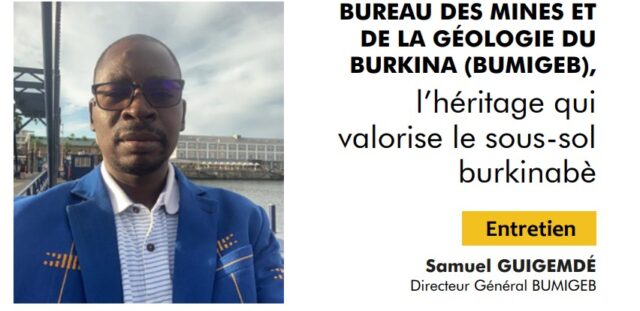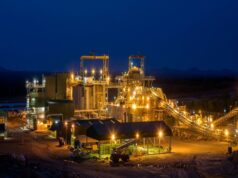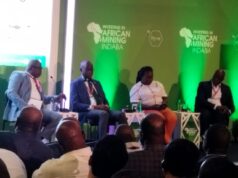The Burkina Faso Bureau of Mines and Geology (Bureau des Mines et de la Géologie du Burkina Faso – BUMIGEB) is a major player in the geology and mining sector. Founded in 1978, BUMIGEB plays a vital role in improving geological knowledge and promoting sustainable exploitation of the varied mineral resources available underground. According to its Director General, Samuel Guiguemdé, the company is a legacy of its predecessors who worked to develop Burkina Faso’s subsoil. In this interview, he looks back at the foundations of the Burkina Faso Bureau of Mines and Geology.
Could you give a brief presentation of BUMIGEB?
The Burkina Faso Bureau of Mines and Geology (BUMIGEB) is the National Geological Service of Burkina Faso. It can be described as the technical arm of the Ministry of Mines. It is a state-owned strategic company whose capital is wholly owned by the Burkina Faso government. It was created in May 1978. It has therefore been in existence for more than forty-five (45) years.
What are BUMIGEB’s main missions?
BUMIGEB has been entrusted with many missions by the State. BUMIGEB’s main missions are to carry out, using all appropriate methods, studies and work designed to improve the country’s geological and mining knowledge, to carry out various mining controls delegated by the State, to support the promotion and development of small-scale mining, to support the promotion and development of mineral and quarry substances contained in the ground and subsoil and, more generally, to undertake or participate in any industrial, commercial, financial, movable or immovable operations that may be related to one of the above-mentioned objects or to any similar or related object.
How is BUMIGEB organised to carry out its missions?
BUMIGEB is headed by a Director General, appointed by the Council of Ministers, whose management is supervised by a Board of Directors. BUMIGEB has a General Directorate, which is supported in the implementation of its activities by units and many other departments, including four (4) technical departments and three (3) departments dealing with administrative, financial, commercial and human resources management issues. The technical departments are made up of the Geological and Mining Research Department, the Laboratories Department, the Drilling Department and the Industrial, Mining and Hydrocarbons Safety Department. The first three are responsible for producing geological maps at various scales and maps of mining potential, which they distribute to potential mining investors to convince them to make Burkina Faso their country of choice for potential investments. BUMIGEB is responsible for security control in industry, mining and the transport and distribution of hydrocarbons. BUMIGEB has a regional office in Bobo[1]Dioulasso, Burkina Faso’s second largest city. It carries out the same activities as BUMIGEB headquarters, but only in the Grand Ouest region. Activities in other parts of the country are carried out by BUMIGEB headquarters.
Burkina Faso has long been described as a country with a poor subsoil. What do you think justifies it being cited as one of Africa’s gold-producing countries today?
Thank you for using this question to pay tribute to our predecessors. To come back to your question, I would say that our predecessors were curious and eager to prove the contrary. You know, we have elders who believed in the Burkinabe subsoil when no one else did. For the love of their country, they took the risk of training abroad in the geosciences. Once back in the country, they worked to set up BUMIGEB and stepped up geological and mining research that proved the opposite. As proof of this, many of the mines operating in Burkina Faso today are in areas whose potential they virtually laid bare. We have inherited not only the results of their research, but also their determination to demonstrate that Burkina Faso’s subsoil is full of other potential. In short, we are perpetuating the legacy that has been bequeathed to us. We are continuing this work, and BUMIGEB is continuing to uncover mineral deposits in Burkina Faso’s subsoil.
What channels does BUMIGEB use to promote geoscientific data on Burkina Faso?
We mainly use three channels. These are our well-organised documentation centre, which is packed with thousands of documents on geological and mining research in Burkina Faso, our geoportal through our website, on which we have worked to put digital files of geological and mining data on Burkina Faso. Finally, we use direct marketing. Through national and international mining forums, we are out to conquer potential mining investors, to whom we present the country’s mining potential.
Speaking of geoportals, it seems that BUMIGEB is in the process of setting up a technical mining hub. What exactly is involved? How will it work?
Indeed, we are in the process of setting up a technical mining hub. In simple terms, this is a digital platform on which the data of key players in the mining sector in Burkina Faso will be grouped together, so as to facilitate access to accurate information from different players in a single location. BUMIGEB is the project leader, but many other players, including the Mining Cadastre and the Burkina Chamber of Mines, will be involved in the project to ensure its successful implementation.
How are BUMIGEB’s activities funded?
BUMIGEB’s financial resources are made up, on the one hand, of resources from the counterpart of five-year plan contracts signed with the State to finance public service missions and, on the other hand, of income from work and services for third parties. BUMIGEB has also received support from bilateral and multilateral cooperation agencies through various mining projects (WB, EU, UNDP, FAC, CIDA, BGR, Holland, Belgium, PADSEM, PARGFM, etc.). There is another source of funding in addition to the first. This is the Fund to finance geological and mining research and support training in the earth sciences (Fonds de Financement de la Recherche Géologique et Minière et de soutien à la formation sur les sciences de la terre – FFRGM), which was established by the 2015 mining code.
Today, only gold is mined in Burkina Faso. Does this mean that the subsoil contains nothing but gold?
Far from it. Remember that in the recent past manganese and zinc were mined in Burkina Faso. Based on these two resources, whose deposits have not been exhausted, it’s easy to see that gold is not the only resource in Burkina Faso. In the distant past, metals such as copper, lead and antimony were mined. On the other hand, many other mineral substances have been identified, but still not exploited, including diamonds, iron, titanium, vanadium, nickel, aluminium, niobium [1] tantalum, tin, lithium and rare earths. In addition to these metalliferous substances, there are non-metallic substances commonly known as quarry substances, such as phosphates, cement limestones, dolomites, marbles, granites, gabbros, sandstones, etc. We are currently stepping up geological and mining research through a number of projects with a view to diversifying our mining production.
So what research projects are you currently carrying out to diversify the mineral substances that can be mined?
We are currently carrying out mapping work at the 1:50,000 scale on more than a dozen sheets. Our ambition is to cover the entire country at this scale. As you know, when it comes to geological mapping, Burkina Faso is one of the most advanced countries in the sub-region. We have completely covered our territory on a scale of 1:200,000, which has enabled us to revise the synthesis map to a scale of 1:1,000,000 (2018). In terms of mining research, the country is fully covered by high-resolution airborne geophysical spectrometry and magnetometry, which has revealed some very interesting anomaly zones that we are currently monitoring in depth on the ground. In the same vein, we are conducting mining research projects for substances that are already well known, such as gold, but also for other specific substances that are now critical, such as rare earths, nickel, manganese, lithium, columbite-tantalite, vanadium, etc. Finally, we have begun studies into sedimentary basins to understand how they work and whether or not there are hydrocarbons, for which we already have a feasibility study and a draft petroleum code.
At what level are the research projects you mentioned earlier?
We have made sufficient progress on some projects. Others are less advanced because of the security situation. But we are firmly convinced that the areas where these projects are located will soon be suitable for stepping up research, enabling us to make considerable progress. We will soon be publishing a technical report on geological and mining research in Burkina Faso, summarising the progress of all our projects.
Can we safely conclude that there are mineral resources other than gold in Burkina Faso’s subsoil?
We have identified many mineral showings that already point to the existence of other mineral resources other than gold in Burkina. Now it’s up to the exploration companies to carry out further research in order to discover new deposits. To do this, we are taking advantage of the forums to interest potential mining investors. On the other hand, we are sparing no effort to make our expertise available to them through partnership agreements in the fields of geological and mining exploration, mining drilling and rock and soil analysis in our ISO 17025 accredited laboratory.
What are BUMIGEB’s prospects for geological and mining research in Burkina Faso?
In terms of prospects, we naturally intend to complete all the projects we are currently working on, which is an undeniable prerequisite for diversifying mining production. At the same time, we want to provide more support to exploration companies in the discovery of other deposits. That’s why we are making it a priority to acquire cutting-edge equipment and build the capacity of our technicians, so that we can live up to their expectations.
You spoke earlier about safety controls in industry, mining and hydrocarbons. Could you tell us more?
These include safety checks on pressure equipment used in industry, mining and even households (I’m talking about butane gas cylinders). We also carry out safety checks on tankers and underground tanks at service stations used to store products such as petrol, diesel, paraffin, etc., not forgetting the quality checks carried out on petroleum and mining products (ingots, jewellery, etc.).
Are these checks carried out in the mines?
Yes, these checks are also carried out in the mines. As you know, the mines themselves operate like industries. So they own pressure equipment, tanks and vats. We take care to carry out these safety checks in them. Also, as the technical arm of the ministry responsible for mines, we accompany the central administration on mine inspection missions. Since we’re talking about mines, we don’t just carry out safety inspections. We are also a major player in the weighing and packaging of gold ingots from the mines.
Some mines are in their last phase of operation, and must therefore move on to the rehabilitation phase. Are you already thinking about how to manage this phase?
Yes, we are anticipating this last phase by strengthening the skills of our technicians in this area in order to succeed in this last phase of the mine’s life cycle.
What role do you think BUMIGEB plays or could play in the successful rehabilitation of these mines?
Building the capacity of our technicians to better launch this rehabilitation phase represents a huge cost for us, which we have to bear despite the absence of any immediate return on our investment. We are doing this because we are aware of the important role we have to play in this phase. To come back to your question, we believe that BUMIGEB must be at the heart of the rehabilitation of our mines, but of course in association with other structures such as the mines themselves, the administration in charge of mines, the ministry in charge of the environment, the university through its earth sciences department, etc.
This article was excerpted from the magazine Spécial #SAMAO2023
Download the entire magazine at this link : https://samao.org/magazine-samao-2023/?fbclid=IwAR1pfgfKbZMz2QBpOlu3fnnWzgAZE7ZOT4E_FZenV3YFXrn81cMaiRQWNas
#Mines_Actu_Burkina










